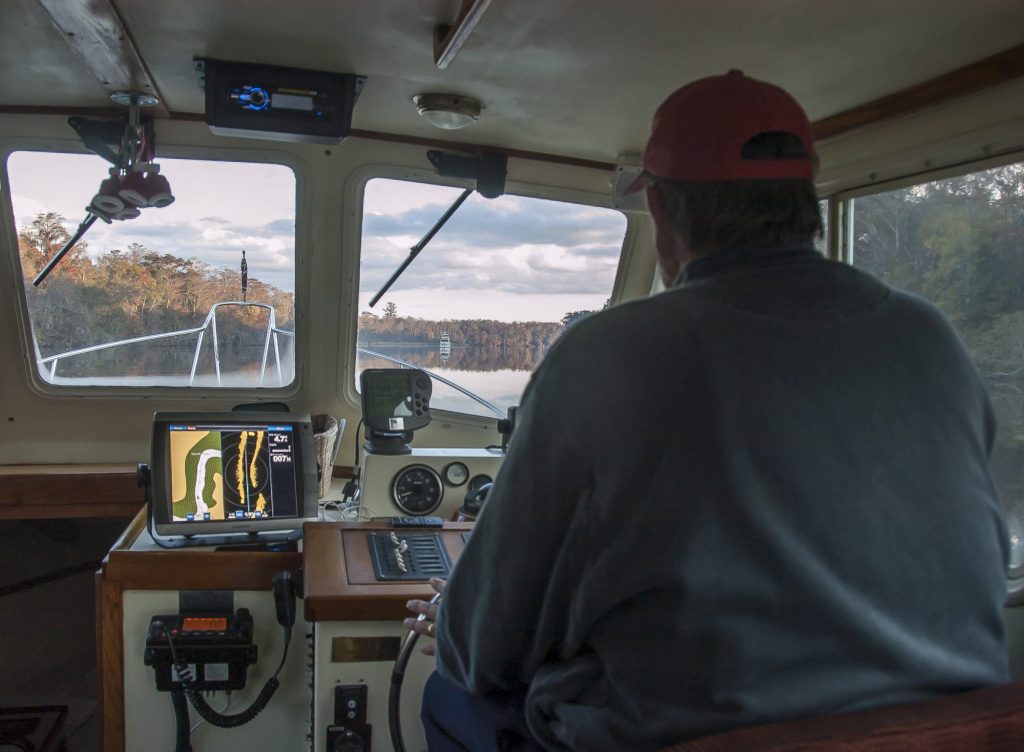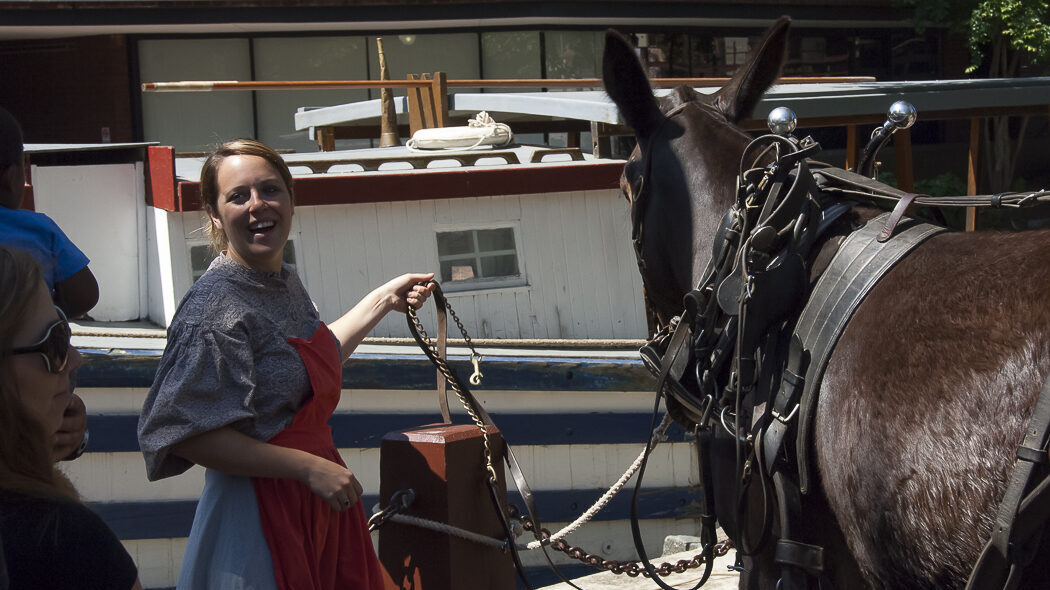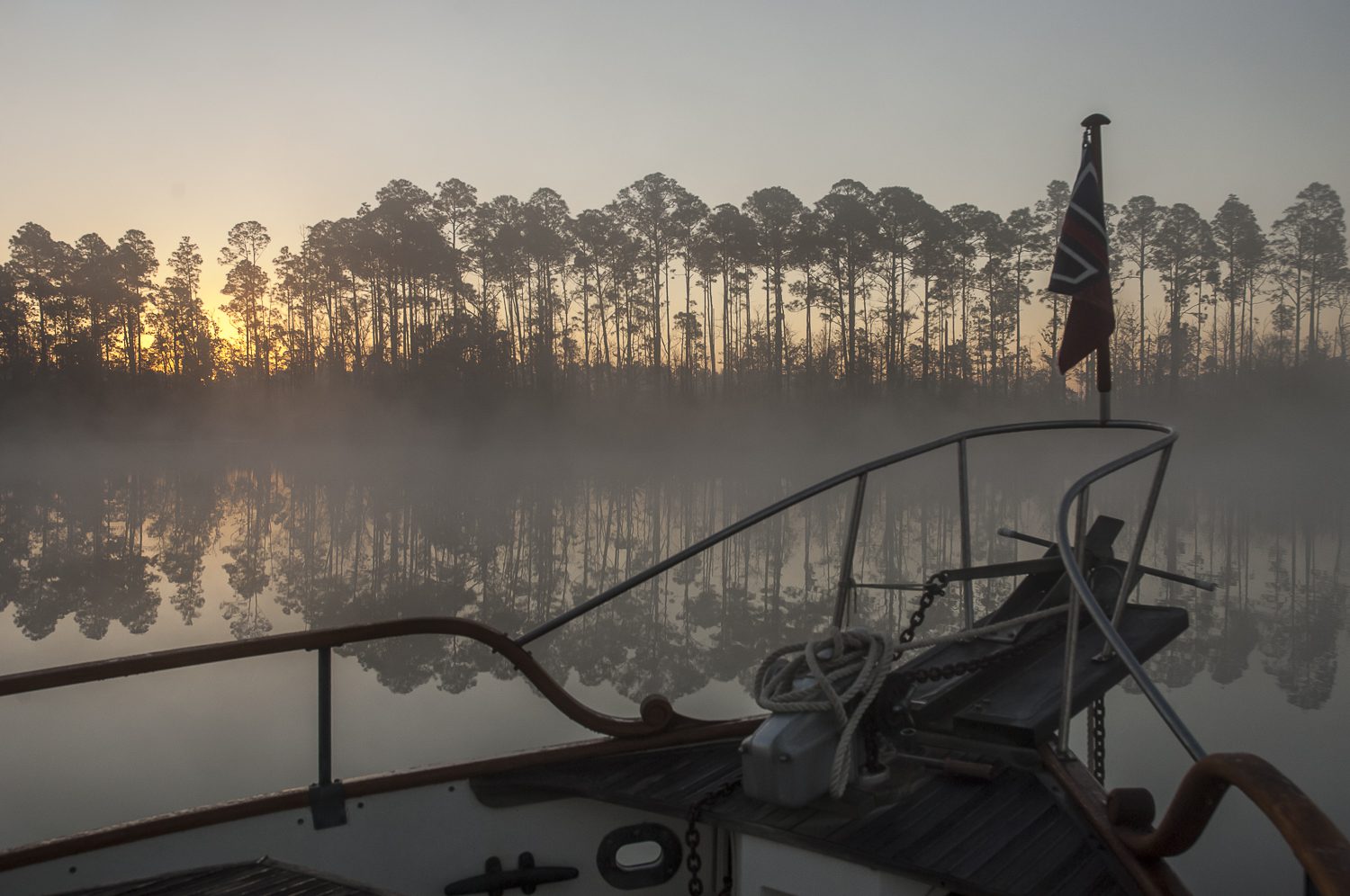Cruising your boat from Norfolk to Miami on the ICW
When I think about the first time we went boating on the Intracoastal Waterway I laugh at how nieve we were. We quit our jobs, rented our home and took off on a year-long boating adventure. That was uur first ICW trip in 1975 on Gusto, a Rhodes 41 sloop. We sailed from Chicago heading to Florida and the Bahamas for the winter. The National Geographic book Intracoastal Waterway was Gene’s selling point. After we both read the book he convinced me we didn’t have to do any scary overnight ocean passages. Boating on the Intracoastal Waterway from Norfolk to Miami was going to be boating on a protected system of rivers and canals. It was all I needed to agree to quit our jobs for a year and take off. I found it to be true that cruising a boat on the Intracoastal Waterway, from Norfolk VA to Miami FL, is a popular protected passage boaters enjoy.
Many years (and boats) later we made the 1,000+ mile cruise aboard Early Bird, a 31-foot lobster yacht from St. Michaels, Maryland on the Chesapeke Bay. Over the years we’ve made several ICW passages on other sailboats and two trawlers and we’ve seen many changes on the waterway. There’s a build-up of houses and condos and the expansion of small boatyards to mega-marina complexes. But there remains miles of lush marshlands, tree-lined shores and natural wildlife that make it such a diverse landscape. The boats on the waterway seem to be larger and better equipped; but there’s a mix of sail and power cruisers in the 35-foot to 45-foot range.

The people aboard run the gamut from professional crew on a mega yacht to a solo sailor on a small boat with an outboard. Many are snowbirds, or annual cruisers who spend their winters aboard and who range from salty seniors to young adventurers. We’ve noticed a growing number of young families with kids who learn remotely and through home schooling. The common thread is getting their boats to southern waters to winter in Florida or cross over to the Bahamas. For some it’s a first leg of many to live and cruise aboard forever.
If you’re planning an ICW trip there are a few basics to decide before committing to the 1,090 mile passage from Norfolk to Miami. They revolve around your boat, your time, and your budget.
Is Your Boat Seaworthy for an Extended Cruise?
Any boat should be seaworthy before its owners head out of their slip for the day, let alone on an extended trip. But if an engine fails when you’re in home waters you know the area and where to find help. If there’s a system failure or emergency when you’re cruising in unfamiliar territory you have to rely on local services. For this, local boaters, cruising guides and online resources are a good reference.

Your ability to handle your boat is another concern. You should have docking and anchoring skills and be comfortable passing and being passed in narrow channels. If you have basic boat handling skills you can easily learn how to go through locks and under bridges. But running aground in a shallow spot can be costly not to mention embarrassing.
We always travel with a supply of spare parts, not expensive ones, but those that are necessary if there’s a breakdown or maintenance is needed. Our stash includes fuel and oil filters, an extra fan belt, and an impeller for the raw water pump. If you do routine basic maintenance underway you’re ready and if there’s a breakdown you’ve got the part for a marina service tech to do the job. At the very least, have a list of replacement parts you might need so it can be ordered. To service instruments we carry extra light bulbs, fuses for the radio, depth sounder, chart plotter and running lights.
Weather conditions
On a cruise south we lost a week to Hurricane Sandy while we were holed up in a marina in Portsmouth VA. It was turmultuous to say the least, but we were safe. When we saw a Navy aircraft carrier head up the river for protection we knew we made the right choice to stay at Ocean Marine Yacht Center while the superstorm swept up the coast. If we had been on a delivery trip that delay would have put a major dent in our schedule. Fortunately, we had the luxury of time and had planned to linger like many who stop and visit some of the charming harbor towns along the way.
Going under bridges and through locks
Timing locks and bridges is a concern because during peak snowbird season traffic going south in the fall and north in the spring is busy. You may have to wait to enter a lock or get under a bridge. There are a lot of brdges spanning the waterway so the height of your boat is important because it may require opening the bridge for passing through it. That means a sailboat or sports fishing boat with a tower may have to wait for an opening. This is something to remember if you’re going through high population areas like Norfolk with heavy rush hour traffic. Car and trucks have priority during busy drive-times over recreational boats.
Low bridges aren’t a concern for a small powerboat, but you may have to wait if you’re not at a bridge for an hourly opening. We use navigation software and apps for this information. And we like the spiralbound The Intracoastal Waterway Chartbook Norfolk to Miami as a handy overall reference. It’s nice to see an overview of where you’re going for planning purposes. If you plan to go further south of Miami to the Florida Keys you may be interested in these two stories The One and Only Key West and Florida Keys A1A Road Trip.
Choose the Virginia Cut or Dismal Swamp Route
Shortly after leaving Norfolk you have to decide to go straight to Albermarle Sound via the Virginia Cut route or turn west to take the Dismal Swamp route. We like both and the routes require going through a lock. The fenders, dock lines and safety gear you carry aboard normally will work for you. But we also bring long dock lines, a fender board and have 2 boat hooks for going through the lock at Great Bridge Lock. Thee are two locks on the Dismal Swamp route.
We like this area of North Carolina. Here’s a story if you want to know more about it A North Carolina Cruise Story.
Timing is everything
First decide: Is the ICW trip a delivery or a destination cruise? That’s an important distinction. If you’re getting your boat to a southern destination as quickly as possible the daily mileage determines how many days you need. Carefully plann your daily runs based on the distance you can travel in a day and include in that calculation where you’ll stop at night. Will you need a marina with fuel and provisioning? Many marinas offer a loaner car for a small amount to go to a grocery store so ask when making a reservation. Or can you find a safe anchorage where you want to stop?
Do the math – calculate mileage and days running
To get a rough estimate of how many days it will take you boating on the Intracoastal Waterway, try this. You know the speed your boat runs at most efficiently and how many hours you want to be underway, so use that to calculate how many days to schedule. For example, if you’re bringing your boat to Fort Launderdale at Mile 1065, that’s 1065 miles from Norfolk. Divide 1065 by let’s say 50 miles a day (number of miles you cruise in a day’s run) and you get approximately 21 days, for a rough estimate of how many days you’ll be underway.
Don’t be tempted to run the ICW at night. We did once thinking the full moon would be a help. It was a nerve wracking experience with me on the bow shining a spotlight across the dark water to see navigation marks. Never again.
Stay and play
Factor in some non-traveling days for bad weather when you’ll stay put. Or the possibility of a mechanical breakdown when you’ll be spending time at a marina for repairs. On a daily basis you may have delays waiting for a bridge with only scheduled openings or one being repaired. And you may find a place like Charleston or Beaufort, South Carolina where you want to spend more time.
Navigating the Waters

The diverse waters – straight landcuts, dicey shallow spots, open ocean inlets and strong tidal currents – can sometimes make boat handling on the ICW a challenge for the best of us. In some stretches of the waterway you’ll fight to stay awake because of the boring miles of landcuts; in other areas your adrenaline will keep you very wide awake.
We keep the VHF radio on to listen to the boats ahead of us talking about the conditions. Falling tides in Georgia can change the scenery and drop water levels significantly so we always ask for local advice at marinas along the way. And Active Captain is an online resource for current conditions and real time experience of boaters who are ahead of you and have posted the conditions they found. Another good resource is CruisersNet.
Don’t forget binoculars
We always carry binoculars on a boat cruise because we use them so frequently. We each have our own because we don’t want to have to readjust them for our difference in eyesight. When we’re looking for navigation marks in the distance, especially approaching an inlet or turbulent waters and new markers may be placed. It’s often difficult to read the numbers on a red or green can bobbing in the water so field glasses give us confidence to know which side of the marker to pass on.
When approaching a marina I use binoculars standing on the bow so I can see the location of a slip assignment. Then I use them to find the slip and see which side of the boat to put the docklines. And it’s handy to know beforehand if there’s a dockhand to catch a line. I use binoculars to look for the light at the entrance to a lock. If it’s green we go in, if it’s red we wait and call the lockmaster for instructions.
What’s Your Budget?
Thrifty cruisers plan their itinerary to anchor out on most nights and schedule stops where provisioning and fuel are available. Marina-wise, I use $2-3 a foot, plus the electrical hook up charge, for a ballpark figure. That’s an average transient rate that can be lower or higher depending on the location and amenities offered. And it’ usually more expensive the farther south you go. If you stop at a marina most nights it can get expensive depending on the length of your boat.
Don’t forget to factor in the cost of eating out. Some of the finest and funkiest restaurants are along the ICW and it sure beats cooking dinner after a long day underway. We always laugh that on some trips we can spend more money wining and dining than we do on anything else. For recommendations we ask local boaters instead of online apps because we found the online resources aren’t always updated.
Being There

Before you leave, do you plan to live aboard at a marina or return to it later? If you plan to leave the boat for a while make sure to have a reservation at a marina where you feel is a safe place. There are many popular areas with equally popular marinas, some with a waiting list. You’ll find several now advertise liveaboard rates where there’s often a dock full of cruisers all with the same enthusiasm for spending the winter on their boat. We found the further south you go, it’s usually more expensive. For example, in northern Florida you can stay at Marineland Marina in St. Augustine for a reasonable amount. More than once when we were living aboard for the winter we met folks looking for a marina with future plans to be winter live aboards. Don’t forget to notice if you need a car to get around.
Impromptu docktail parties along the way

During those miles underway boating on the Intracoastal Waterway the trip can become a very social affair. We call them doctail parties. It doesn’t take long to develop a sense of comraderie with other cruisers who you’ve seen along the way. Often you meet boaters who probably travel at the same speed and distance you do. When you meet at a dock it’s only natural to share a drink and talk about your days on the waterway. However you go – as a quick delivery or as a laid back cruise, the Intracoastal Waterway is an adventure you won’t forget and you’ll make new friends and share experiences you’ll always cherish.
Some of our favorite places to stop boating on the Intracoastal Waterway include Osprey Marina in South Myrtle Beach SC, Isle of Hope Marina in Isle of Hope, GA and Marineland Marina in Marineland, FL and Cocoa Village Marina in Cocoa, FL.
Links to Resources
- Atlantic ICW by Waterway Guide
- Atlantic Intracoastal Waterway Chartbook
- On the Water Chart Guides
- Garmin’s Active Captain
- A North Carolina Cruise Story
- Florida Keys Road Trip on A1A
- Choosing Binoculars for Boating
- Legs of the Great Loop Cruise
Gene and Katie Hamilton are veteran sail and power boaters and award winning boating writers. They are authors of Coastal Cruising Under Power and Practical Boating Skills. They are members of the Outdoor Writers Association of America.
Post Views: 7,934
|













